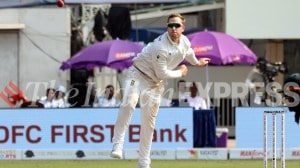Punjab and Haryana High Court issues notice to Chandigarh, Punjab on security gap for Beant Singh blast witness
Balwinder Singh, who identified the car and key conspirators in the 1995 Beant Singh assassination, alleges that Punjab Police guards indulge in drugs and alcohol on duty.
 Justice Bhardwaj also granted time to the respondents for compliance, amid allegations that despite multiple prior directives, the security provided to Balwinder Singh, the 54-year-old petitioner, remains “inadequate and ineffective.” (Express Photo)
Justice Bhardwaj also granted time to the respondents for compliance, amid allegations that despite multiple prior directives, the security provided to Balwinder Singh, the 54-year-old petitioner, remains “inadequate and ineffective.” (Express Photo)The Punjab and Haryana High Court Thursday issued notices to the Chandigarh Administration and the Punjab Government on a petition by Balwinder Singh, the prime witness in the 1995 assassination of former chief minister Beant Singh, seeking immediate and effective police protection from ongoing threats by Khalistani terrorists.
The single-judge bench of Justice Vinod S Bhardwaj issued notice of motion, directing respondents, including the director generals of police of Punjab and Chandigarh, and the senior superintendent of police, Chandigarh, to file replies by the next hearing on December 11.
Justice Bhardwaj also granted time to the respondents for compliance, amid allegations that despite multiple prior directives, the security provided to Balwinder Singh, the 54-year-old petitioner, remains “inadequate and ineffective.”
Balwinder, a resident of Nayagaon in Mohali district, has lived under the shadow of reprisal for nearly three decades since his testimony helped crack one of India’s most audacious terror plots.
On August 31, 1995, a suicide bomber detonated an RDX-laden Ambassador car outside the Civil Secretariat in Chandigarh, killing Beant Singh, then Punjab’s 12th chief minister, and 16 others in a blast that shook the foundations of the state’s fight against Khalistani separatism.
The attack, attributed to Babbar Khalsa International (BKI) and Khalistan Commando Force (KCF), targeted Beant for his aggressive crackdown on militants during a period of intense insurgency.
As detailed in the petition filed by Advocate Nikhil Ghai, Balwinder’s role was pivotal: Working as a car painter and mechanic in Sector 7C, Chandigarh, he unwittingly painted the steel-grey Ambassador (registration DL 7C DBA-958) white just days before the blast.
The vehicle, purchased from a Delhi doctor’s cousin and modified for the suicide mission, was brought to his shop on August 26, 1995, by Lakhwinder Singh (alias Lakha), a drug-addicted rogue police constable, and Dilawar Singh, the eventual bomber and another turncoat constable.
“I had no idea it was for such a heinous act,” Balwinder recounted in his affidavit, describing how the militants returned on August 29-30 for final touches, including denting and a front mirror installation by co-conspirator Balwant Singh Rajoana, later convicted and sentenced to death (commuted to life in 2019).
Balwinder’s fingerprints even ended up on the car due to wet paint, providing forensic links that aided the probe by the Central Bureau of Investigation (CBI).
Two days after the explosion, on September 2, Balwinder spotted a newspaper photo of the mangled vehicle and matched its number plate. His disclosures not only traced the car but also revealed hideouts in Kansal village (near Mata Mandir), and the identities of the plotters, enabling arrests and unravelling the conspiracy masterminded by Jagtar Singh Hawara and others.
For his courage, Balwinder received a Rs 10 lakh reward from former CBI director Vijaya Ramarao, but no initial protection was provided. Over the years, courts have repeatedly intervened and given him security.
But Balwinder Singh alleges that the “security personnel presently deputed are unprofessional and indulge in intoxication while on duty.” Singh now prays for a time-bound threat assessment by a joint CBI-SIT, interim CRPF/elite guard deployment, biometric checks on personnel, and a decision on his representation to the Chandigarh DGP.





- 01
- 02
- 03
- 04
- 05


























